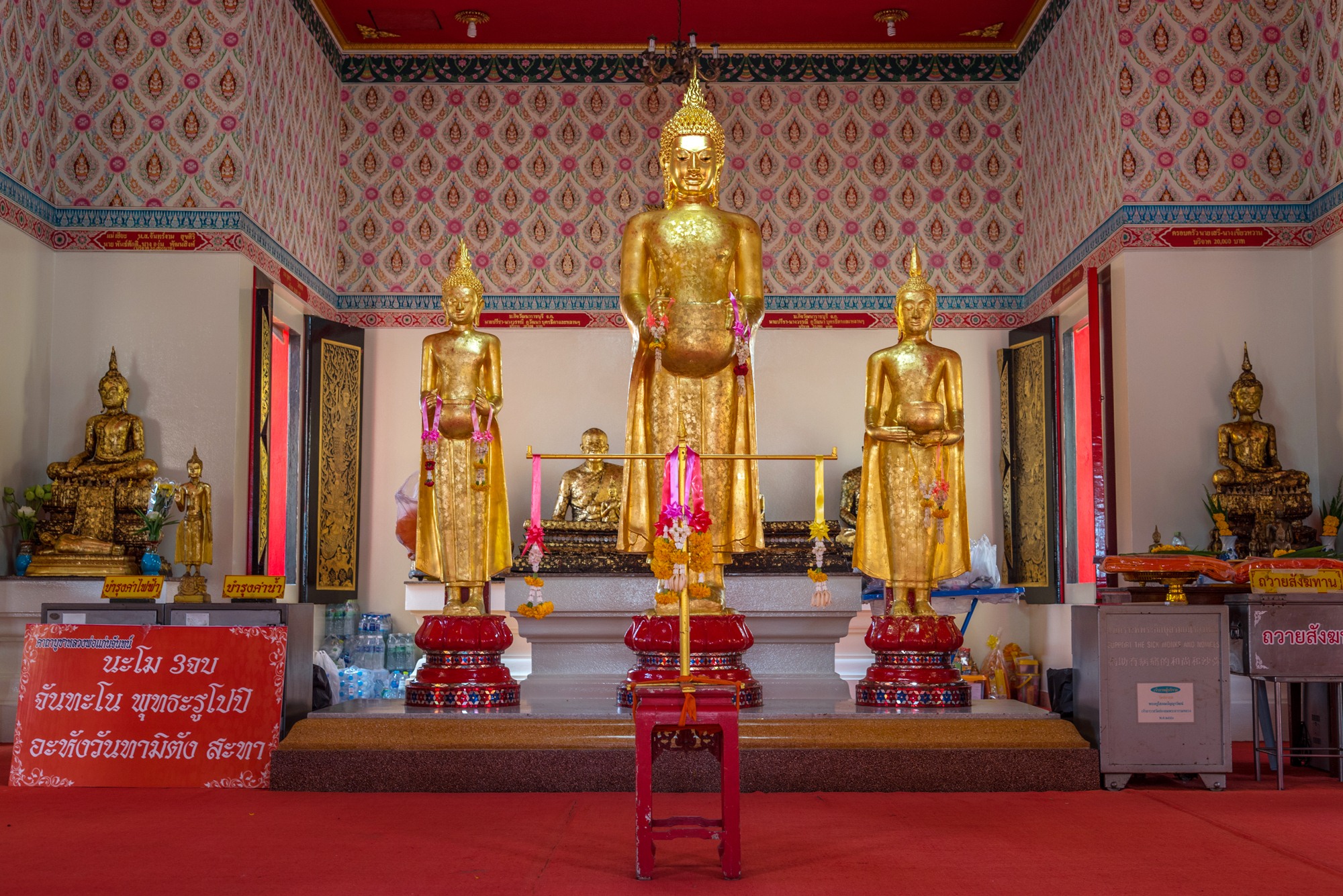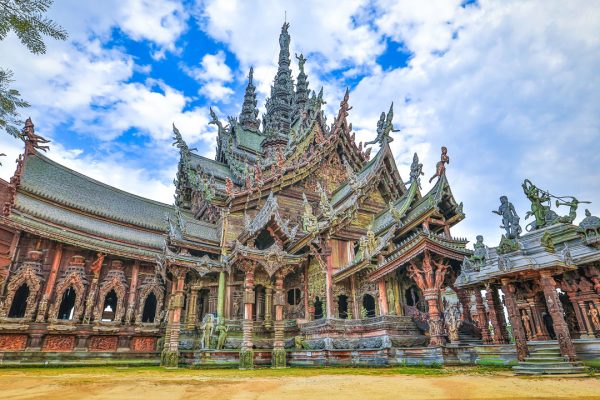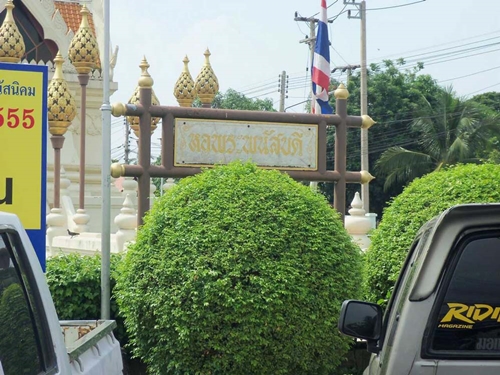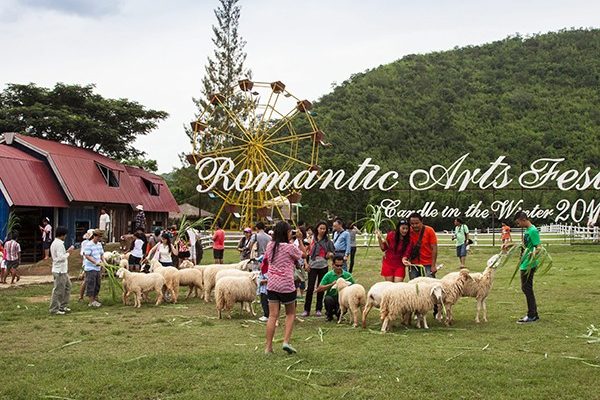
Luang Pho Kaenchan
Luang Pho Kaenchan is a sandalwood Buddha image with a height measured from head to toe of 2.26 metres. It is in a standing position with its arms holding an alms bowl; however, if we look at the statue closely, we will see that its alms bowl is not like others’. Luang Pho Kaenchan’s alms bowl looks like it is in a sack with something that is about 25 centimetres long and resembles two pieces of cloth for carrying the alms bowl stretching out from the bowl’s rim. In addition, it seems as if the statue itself were holding the cloth with its two hands in order to prevent the alms bowl from falling. There are two stories of Luang Pho Kaen Chan’s origin. First of all, it is believed that it was made in Kanchanaburi. History has it that there was once a man travelling into the jungle to find wild items. He saw a huge tiger so he quickly climbed up the tree. He then prayed for his survival and made a promise that if surviving, he would use the wood of the tree he climbed up to carve into a Buddha image. Luckily, he did survive and arrived home safely. The following day he and other villagers went into the jungle to cut down the tree and found that it was actually a sandalwood tree whose wood is very rare and expensive. They then cut it down and took it to a craftsman in Ban Kaeng Luang in order to have him carve it into a Buddha image. After completed, the Buddha image was hosted in Ban Kaeng Luang for people to pay their respect to. After that, one day the statue was found floating down the river. It is assumed that in the eleventh and the twelfth lunar months in which flooding occurred, the Buddha image was washed into the Mae Klong River by a mass of water from heavy rain. Additionally, it is said that when it floated past any riverfront temples, locals would see it and try to pick it up from the river. However, no matter how hard they tried, they failed. None of the temples that it floated past managed to pick it up and house it; however, when it reached the part of the river that passes Wat Mai Chong Lom, it miraculously floated back and forth, not down the river as before, despite the fast-flowing waters. The then abbot of Wat Mai Chong Lom told monks and locals to pay their homage to it and pray to it for a permission to bring it up from water. After that, they went down to the river and were able to take the statue up from water with ease. After it was hosted in the temple, a celebration was held. In the past, on the fourteenth waxing moon day of the twelfth lunar month of every year, a fluvial procession to celebrate Luang Pho Kaen Chan was held; however, nowadays a car is used in the procession instead of a boat and the procession is held on the first day of the Songkran festival. On that day, the Buddha image is put in the back of a beautifully decorated pickup truck. The car will go along the streets around Ratchaburi City’s market to let locals pay respect to the statue with monks sitting in the back of the pickup truck sprinkling Luang Pho Kaen Chan’s holy water at the faithful. In front of the car is a procession of people dancing and blowing horns. After the procession ends, the Buddha image will be temporarily hosted for six days in front of the Service Company of the Engineer Department Royal Thai Army where people can come and pay homage to it.According to another story of the Buddha image, Luang Pu Chan, former abbot of Wat Mai Chong Lom, was, apart from a monk, a carpenter. He built four wooden pavilions to cover four Buddha images found in front of the Phra Prang of Wat Mahathat of Ratchaburi, which was nearly abandoned at that time. After completing the wooden pavilions, he found several heads of Buddha images lying all over the floor along the temple’s cloister. He found a part from head to chest of a bronze Buddha image and thought it was beautiful. He then took it back to Wat Mai Chong Lom with him. Later on, he used sandalwood to make the statue’s body from chest to toe and arms as well as an alms bowl. When completed, it was a magnificent standing Buddha image holding an alms bowl and was hosted in the temple’s old Wihan. In the tenth and eleventh lunar month in which flooding occurred, the Wihan flooded for two months. The Buddha image miraculously appeared in the dream of Luang Pu Poh, or Phra Ratchakhemachan, fourth abbot of the temple, to tell him that its feet hurt. The next morning, he had a monk check the Buddha image in the Wihan. Its feet were found destroyed by termites; as a result, Luang Pu Poh had it renovated, lacquered and gilded. After that it was hosted in the temple’s main hall. Visitors have been allowed to gild the statue since then. Luang Pho Kaen Chan is now hosted in a Wihan with four gable ends which was built by the order of Phra Thepyanamuni (Prathet Kawitharo Pariantham 6), former abbot of Wat Mai Chonglom and consultant of Ratchaburi’s then provincial abbot. Somdet Phra Thirayanmuni (Thi Punnako) of Wat Chakkrawat Racha Wat presided over the foundation stone laying ceremony. On 30th September 1981, Phra Buddha Khosachan (Fuen Chutintharo) of Wat Sam Phraya presided over the ceremony of lifting Chofah. On 24th January 1982, Luang Pho Kaenchan was relocated from the main hall to the newly built Wihan. Then the celebration of the new Wihan was held.The temple is open to the public every day from 7:00 to 17:00




